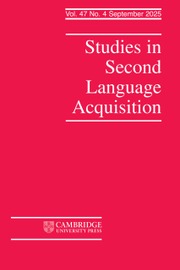Article contents
JAPANESE ADULT LEARNERS' DEVELOPMENT OF THE LOCALITYCONDITION ON ENGLISH REFLEXIVES
Published online by Cambridge University Press: 21 May 2002
Abstract
This study explores the developmental pattern observed when Japanese adult learners acquirethe locality condition on English reflexives. Experimental tasks were designed specifically to dealwith the methodological problems of earlier research and then administered to Japanese learnersof English at five proficiency levels (n = 411) as well as English and Japanese controlgroups (n = 40). Results from the learner groups indicate that the locality condition isacquired significantly better with sentences containing embedded that-clauses (typeE-1) than with sentences containing embedded infinitival clauses (type E-2). This asymmetryexists even at beginning stages of learning and persists through later stages. For type E-2 clauses,there is an appreciable percentage of advanced learners (about 35% in this study) who failed toacquire the locality condition, which, I argue, is extremely difficult to account for within the UGmodels proposed thus far.
Information
- Type
- Research Article
- Information
- Copyright
- 2002 Cambridge University Press
- 10
- Cited by

